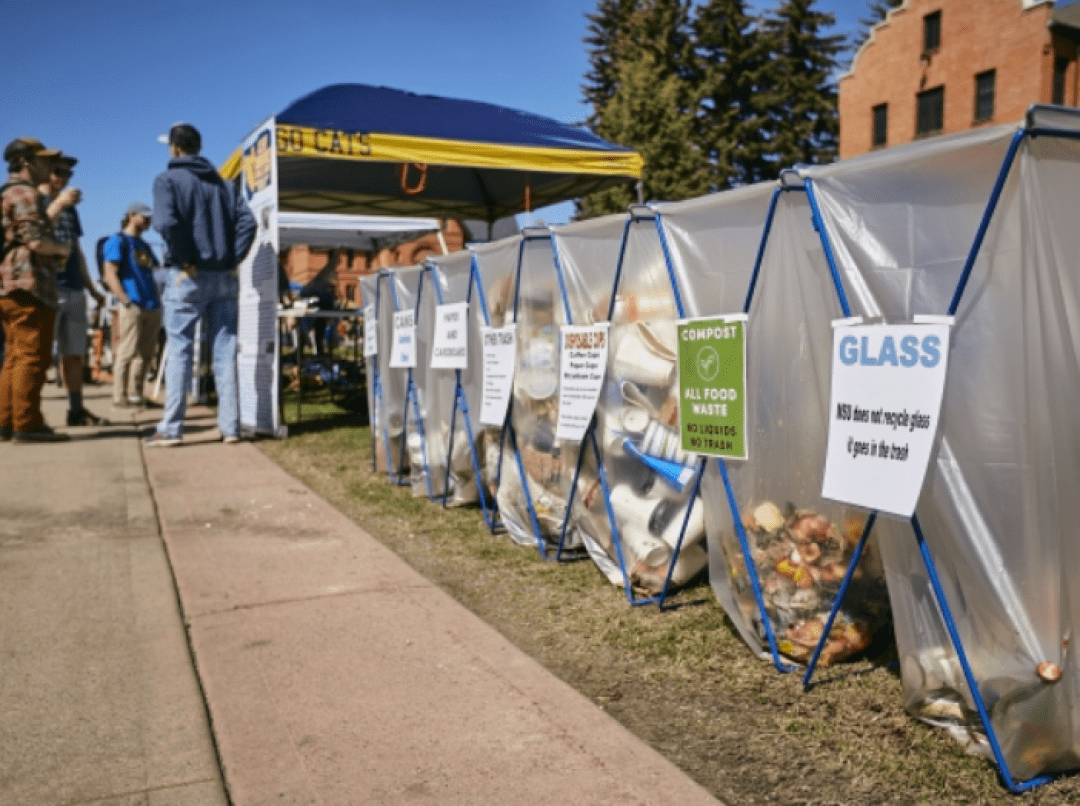After a decade, waste management at MSU is more efficient than ever
The determination of a few students helped jumpstart Montana State University’s waste management and recycling program. In fact, MSU’s Office of Sustainability may not have existed without them.
“At the beginning, it was all student-funded and student-driven,” said MSU sustainability director Kristin Blackler, who came on board in 2013 when the Office of Sustainability was created. “When I got here, I saw such dedication from students that it almost brought tears to my eyes.”
In 2009, the MSU student body proposed, voted on and approved a sustainability fee of $3.50 per semester to fund a recycling program on campus. Student employees and a part-time staff member collected recycling around campus each week, and the university had a diversion rate of 2.5%.
Diversion rate, said Blackler, is the percentage of MSU’s total waste, by weight, that doesn’t end up in a landfill. The Office of Sustainability’s goal is to make that percentage as high as possible.
Once the student body approved the sustainability fee, recycling bins were placed in a few locations on campus. More were added in other buildings as money became available, but eventually they reached the limit of what $7 per student per year could accomplish. In order to more efficiently share and use resources, the recycling program became part of MSU’s Facilities Services in 2018.
“In 2012 and 2013 we started to become more organized and growth happened quickly,” said Logun Norris, MSU’s recycling coordinator. Norris began as one of those student employees, collecting recycling in the early mornings, joining the staff of the Office of Sustainability after he graduated. “Now, nearly every academic building has recycling, and some buildings have multiple stations per floor.”
Recycling was eventually added to student residence halls, family and graduate housing, football games and other campus events, helping increase the diversion rate to nearly 13% by 2015. And with the recycling program well established, the office was able to shift some attention to another element of waste.
“The recycling is really important, but we had this whole other aspect that we weren’t even touching, which is food waste,” said Blackler. “We’re the largest institutional food service in the state, serving more than 15,000 meals a day, so we wanted to get a better understanding of what our food waste situation looked like.”
To do that, the Office of Sustainability partnered with faculty members Carmen Byker Shanks and Selena Ahmed of MSU’s Department of Health and Human Development in 2015. Along with members of their classes in the College of Education, Health and Human Development, Byker Shanks and Ahmed did waste audits measuring both pre- and post-consumer waste for Miller Dining Commons, assessing how much food was being thrown away, both before serving and after.
Those audits led to changes as simple as smaller plates and serving utensils, as well as working with MSU Culinary Services to evaluate the amount of food being ordered. With the help of a grant from MSU’s Strategic Investment Proposal program, an area near campus transformed into a compost site. From before the Miller Dining Commons renovation in 2015 to post-renovation in 2016, food waste was cut in half. And when Rendezvous Dining Pavilion opened in 2018, everything students used was either compostable or reusable.
In 2018, the city of Bozeman reached out to form a composting partnership with the university. The city had previously only composted residential yard waste, but wanted to test some new equipment by composting MSU’s food waste.
“The first year we partnered with the city, we composted about 540,000 pounds of food waste,” said Norris. “This year, we’re on track to divert 650,000 pounds. Our food waste right now is 35% of our total diverted waste on campus, and we’re able to collect from nearly all our food service locations. Without that partnership, we wouldn’t be able to divert nearly as much food waste from the landfill.”
After being processed at city facilities, that compost ends up in parks and gardens around the Gallatin Valley, including on the MSU campus. Through the Office of Sustainability’s efforts, MSU’s diversion rate continued to climb and is on track to reach 36% for fiscal year 2020.
Blackler said the Office of Sustainability has more goals yet on the horizon. During the fall semester of 2019, for instance, the university hosted its first two “zero-waste” events — MSU’s First Meal and its Welcome Back Barbecue — where less than 1% of waste went into a landfill.
“I can remember having people laugh in my face when I would talk about zero-waste events,” said Blackler. “It’s all about how we can remove the barriers to each person being able to recycle or compost, and what kind of infrastructure we need to set up to make that happen. That’s been a really fun, interesting challenge, and we made it happen.”
MSU has also created a “move-in, move-out” program, which first began as a class project overseen by undergraduate volunteers. As students moved out of their residence halls at the end of the academic year, many of the things they had bought for moving in, while still in working condition, were getting thrown away. The program allows the students to donate appliances, décor and furniture for resale to incoming students, for a fraction of the price, the following fall.
Eventually, said Blackler, the goal of sustainability is to divert 100% of waste – no more trips to the landfill. It might be a long road, but she believes it’s possible.
“I don’t think we’ve ever had to justify why this is important to campus,” she said. “For so long we were struggling to keep up with the demands of a growing campus. Now we’re in a really good place on that front, and our next steps are building the education and outreach around the foundation we already have.”
To learn more about MSU waste diversion practices, please visit the Office of Sustainability website.